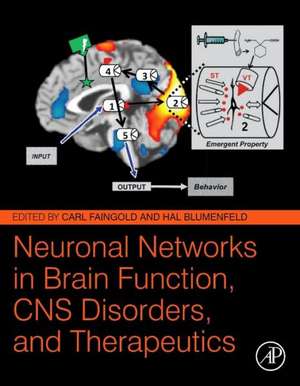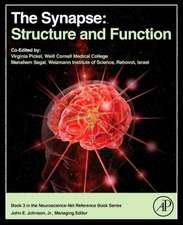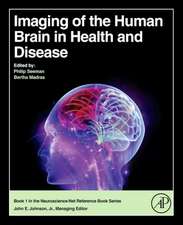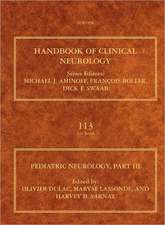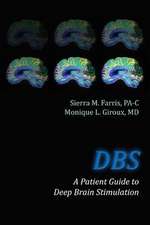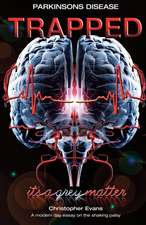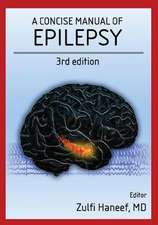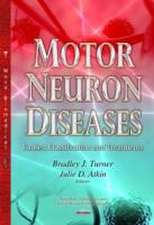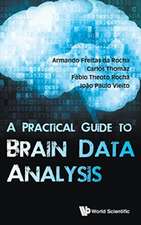Neuronal Networks in Brain Function, CNS Disorders, and Therapeutics
Editat de Carl Faingold, Hal Blumenfelden Limba Engleză Hardback – 5 mar 2014
With chapters authored by experts in each topic, this book advances the understanding of:
- How the brain carries out important tasks via networks
- How these networks interact in normal brain function
- Major mechanisms that control network function
- The interaction of the normal networks to produce more complex behaviors
- How brain disorders can result from abnormal interactions
- How therapy of disorders can be advanced through this network approach
- Utilizes perspectives and tools from various neuroscience subdisciplines (cellular, systems, physiologic), making the volume broadly relevant
- Chapters explore normal network function and control mechanisms, with an eye to improving therapies for brain disorders
- Reflects predominant disciplinary shift from an anatomical to a functional perspective of the brain
- Edited work with chapters authored by leaders in the field around the globe – the broadest, most expert coverage available
Preț: 658.21 lei
Preț vechi: 865.23 lei
-24% Nou
Puncte Express: 987
Preț estimativ în valută:
125.96€ • 136.78$ • 105.81£
125.96€ • 136.78$ • 105.81£
Carte tipărită la comandă
Livrare economică 15-29 aprilie
Preluare comenzi: 021 569.72.76
Specificații
ISBN-13: 9780124158047
ISBN-10: 0124158048
Pagini: 512
Ilustrații: black & white tables, figures
Dimensiuni: 216 x 276 x 30 mm
Greutate: 1.68 kg
Editura: ELSEVIER SCIENCE
ISBN-10: 0124158048
Pagini: 512
Ilustrații: black & white tables, figures
Dimensiuni: 216 x 276 x 30 mm
Greutate: 1.68 kg
Editura: ELSEVIER SCIENCE
Public țintă
Neuroscience researchers, clinical neuroscience practitioners, neuropharmacologistsCuprins
1. Introduction to Neuronal Networks of the Brain
2. Network Computer Modeling
3. Functional Magnetic Resonance Imaging in Epilepsy: Methods and Applications Using Awake Animals
4. Network Experimental Approaches: Inactivation, Microinjection, Neuronal Stimulation, and Recording
5. Network Experimental Approaches – ex vivo and ex vivo Networks
6. Network Imaging and Neuronal Firing
7. Network Control Mechanisms - Neuroactive Substances and Cellular Inputs
8. Network Control Mechanisms – Volume Transmission
9. Bursting in the Brain - From Cells to Networks
10. Network Control Mechanisms – Cellular Milieu
11. Neuronal Network Mechanisms - Sex and Development
12. Astrocytic Regulation of Synapses, Neuronal Networks and Behavior
13. The Fear Memory Network
14. Orchestration of the Circadian Clock Network by the Suprachiasmatic Nucleus
15. mTOR Signaling in Cortical Network Development
16. Network Control Mechanisms - Synaptogenesis and Epilepsy Development
17. The Brain and Spinal Cord Networks Controlling Locomotion
18. The Brainstem Respiratory Network
19. Visual Network
20. Auditory Neuronal Networks and Chronic Tinnitus
21. Consciousness and Subcortical Arousal Systems
22. Networks of Normal and Disordered Sleep
23. Networks for the Modulation of Acute and Chronic Pain
24. Networks in Mood and Anxiety Disorders
25. Neuronal Networks and Therapeutics in Neurodegenerative Disorders
26. Neuronal Networks in Epilepsy: Comparative Audiogenic Seizure Networks
27. Physiological and Pathophysiological Expansion of Neuronal Networks
28. Neuronal Network Plasticity and Network Interactions are Critically Dependent on Conditional Multireceptive (CMR) Brain Regions
29. Neuronal Network Interactions in the Startle Reflex, Learning Mechanisms, and CNS Disorders, Including Sudden Unexpected Death in Epilepsy
30. Emergent Properties of Neuronal Networks
31. Neuronal Network Involvement in Stimulation Therapies for CNS Disorders
32. Neuronal Network Effects of Drug Therapies for CNS Disorders
33. Future Trends in Neuronal Networks - Selective and Combined Targeting of Network Hubs
2. Network Computer Modeling
3. Functional Magnetic Resonance Imaging in Epilepsy: Methods and Applications Using Awake Animals
4. Network Experimental Approaches: Inactivation, Microinjection, Neuronal Stimulation, and Recording
5. Network Experimental Approaches – ex vivo and ex vivo Networks
6. Network Imaging and Neuronal Firing
7. Network Control Mechanisms - Neuroactive Substances and Cellular Inputs
8. Network Control Mechanisms – Volume Transmission
9. Bursting in the Brain - From Cells to Networks
10. Network Control Mechanisms – Cellular Milieu
11. Neuronal Network Mechanisms - Sex and Development
12. Astrocytic Regulation of Synapses, Neuronal Networks and Behavior
13. The Fear Memory Network
14. Orchestration of the Circadian Clock Network by the Suprachiasmatic Nucleus
15. mTOR Signaling in Cortical Network Development
16. Network Control Mechanisms - Synaptogenesis and Epilepsy Development
17. The Brain and Spinal Cord Networks Controlling Locomotion
18. The Brainstem Respiratory Network
19. Visual Network
20. Auditory Neuronal Networks and Chronic Tinnitus
21. Consciousness and Subcortical Arousal Systems
22. Networks of Normal and Disordered Sleep
23. Networks for the Modulation of Acute and Chronic Pain
24. Networks in Mood and Anxiety Disorders
25. Neuronal Networks and Therapeutics in Neurodegenerative Disorders
26. Neuronal Networks in Epilepsy: Comparative Audiogenic Seizure Networks
27. Physiological and Pathophysiological Expansion of Neuronal Networks
28. Neuronal Network Plasticity and Network Interactions are Critically Dependent on Conditional Multireceptive (CMR) Brain Regions
29. Neuronal Network Interactions in the Startle Reflex, Learning Mechanisms, and CNS Disorders, Including Sudden Unexpected Death in Epilepsy
30. Emergent Properties of Neuronal Networks
31. Neuronal Network Involvement in Stimulation Therapies for CNS Disorders
32. Neuronal Network Effects of Drug Therapies for CNS Disorders
33. Future Trends in Neuronal Networks - Selective and Combined Targeting of Network Hubs
Recenzii
"The book is a welcome and scholarly recognition of the growing importance of networks in neuroscience and neurological care." "Students and practitioners of Neuroscience, Neurology, Psychiatry, Pharmacology and Information Science as applied to the brain will find this to be a useful summary of systems data and a new conceptual framework." --Robert S. Fisher, MD, PhD, Professor of Neurology and Director, Comprehensive Epilepsy Center, Department of Neurology and Neurological Sciences, Stanford University Medical Center
"This volume, edited by Carl Faingold and Hal Blumenfeld, focuses on neural networks – what they are, how we study them, and why they are important for understanding normal brain function and treating neuropathologies. The topic is timely and important. Indeed, there is a wealth of information (and a large number of ongoing studies) that deals with the identification and understanding of brain networks, and this volume attempts to bring much of that information together in a coherent package. Of particular importance is the concept of "emergent properties" of a network – characteristics of a network’s function that are not observed in the member elements and may not be predictable simply by looking at the members of the network…research on network modulation/disruption will contribute powerful new tools to our therapeutic armamentarium." --Philip A. Schwartzkroin, Ph.D., Professor emeritus, Department of Neurological Surgery University of California, Davis
"Many of the chapters provide outstanding thoughtful, timely, and information-packed reviews of interesting topics…this book will be useful and important to anyone interested in mammalian systems neurobiology, and especially to those to whom basic science/clinical implications matter deeply." --Roger D. Traub, M.D., Dept. Physical Sciences, IBM T.J. Watson Research Center, Yorktown Heights, NY
"This volume, edited by Carl Faingold and Hal Blumenfeld, focuses on neural networks – what they are, how we study them, and why they are important for understanding normal brain function and treating neuropathologies. The topic is timely and important. Indeed, there is a wealth of information (and a large number of ongoing studies) that deals with the identification and understanding of brain networks, and this volume attempts to bring much of that information together in a coherent package. Of particular importance is the concept of "emergent properties" of a network – characteristics of a network’s function that are not observed in the member elements and may not be predictable simply by looking at the members of the network…research on network modulation/disruption will contribute powerful new tools to our therapeutic armamentarium." --Philip A. Schwartzkroin, Ph.D., Professor emeritus, Department of Neurological Surgery University of California, Davis
"Many of the chapters provide outstanding thoughtful, timely, and information-packed reviews of interesting topics…this book will be useful and important to anyone interested in mammalian systems neurobiology, and especially to those to whom basic science/clinical implications matter deeply." --Roger D. Traub, M.D., Dept. Physical Sciences, IBM T.J. Watson Research Center, Yorktown Heights, NY
